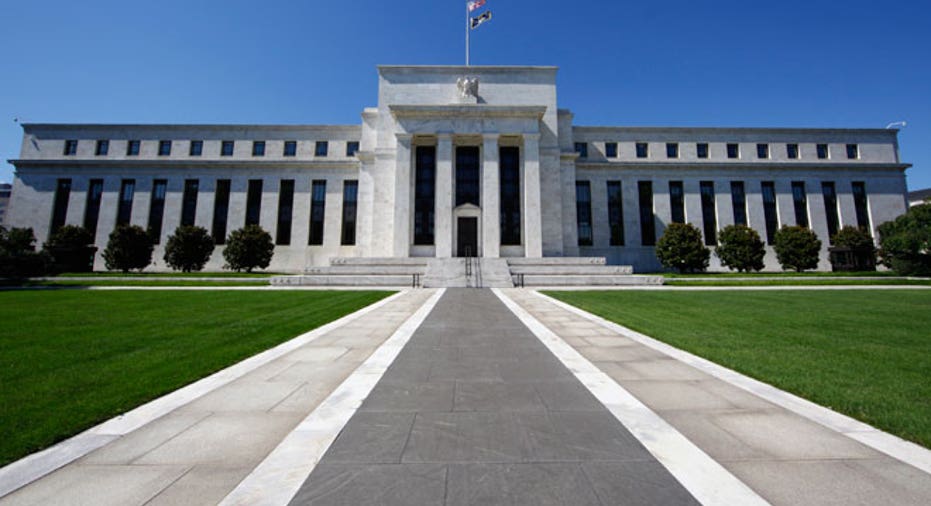Jobs Turn Ugly. Will Fed Swoop In?

Is the economy improving? And is the Federal Reserve's current monetary policy appropriate?
Going into the Federal Open Market Committee meeting Wednesday, spectators can expect a resounding "yes" on the second point -- and a measured affirmation to the first.
Jobs Still a Worry
Some recent economic data support the view that the recovery remains tentative and that very accommodative policies are still necessary. The March employment numbers came in well under expectations, and the number of initial jobless claims for unemployment benefits has unexpectedly climbed in recent weeks since hitting a low point in February. As reported on April 19, initial jobless claims rose to 386,000 for the week ending April 14. The previous week came in at 370,000, later revised up to 388,000.
With the intense focus on employment, not to mention housing, articulating the degree to which the economy has improved could be a slippery matter for the Fed.
There are bright spots. For instance, retail spending was up in March, and the Beige Book, released last week, reported modest to moderate economic expansion in all 12 Federal Reserve districts.
Still, the huge uncertainty hovering over the category of employment casts a pall on the more positive data, and there is concern that growth will not be robust enough to sustain the downward overall trend in unemployment.
"I anticipate that growth in real gross domestic product will be sufficient to lower unemployment only gradually from this point forward, in part because substantial headwinds continue to restrain the recovery," Federal Reserve Vice Chair Janet Yellen said in a speech given April 11 at New York University.
The Economy Isn't Bad Enough for QE3
Despite the possibility that sluggish expansion of GDP could slow down job growth, the minutes from the last meeting revealed that only a "couple of members indicated that the initiation of additional stimulus could become necessary if the economy lost momentum."
At this point, it could take a sharp downturn to rouse enthusiasm for more quantitative easing measures.
"What will turn the tide at the Fed and bring on another QE? A collapse in job growth, inflation dropping back toward zero, a persistent decline in stock prices, and another significant decline in home sales and prices," says Bernard Baumohl, chief global economist at the Economic Outlook Group in Princeton, N.J.
Nevertheless, speculation continues to swirl around a possible stimulus move by the Fed in some quarters.
Continued Belief in QE3 Helps Fed Policy
The ongoing "will they or won't they" question on QE helps the Fed achieve its aim of low interest rates.
"As long as the belief is there that they will do something, you get a lot of investors in the market to plan on it -- and that helps keep rates low. And that's what they're trying to do for now," says Brian Rehling, chief fixed income strategist at Wells Fargo Advisors.
When perceptions and reality collide, if the Fed does turn away from QE after all, long-term interest rates could rise, and the stock market could react negatively as well. The stock market did tumble when the minutes from the last meeting revealed the long odds on more easing.
"In the short term, you might get some selling. But longer term, if the Fed is not implementing QE because the economy and jobs are improving, ultimately that would be good news for the stock market," Rehling says.
2014 Pledge
Given the dovish bent of the committee's voting members this year, no changes will be made to interest rates or to the forward rate guidance.
The Fed is expected to reiterate the pledge to keep rates at the current level, targeting between zero percent and 0.25% until 2014. It's also expected to continue Operation Twist, which is scheduled to end June 30.
Operation Twist began in October. Rather than launch another all-out round of QE, the Fed embarked on a plan to sell $400 billion of short-term Treasury securities, already on the Fed's books, and buy longer-term bonds with an eye toward tamping down long-term interest rates.
The traditional lever controlling monetary policy, the federal funds rate, has essentially been in the "off" position since December 2008. Economic improvements could bring the inevitable rate increase to the fore despite the 2014 pledge.
Addressing that very issue, next week's FOMC meeting will deliver a new batch of charts from the Summary of Economic Projections, or SEP, two of which will illustrate FOMC members' thoughts on the path of the federal funds rate over the next several years and when policy should be tightened.
The full Summary of Economic Projections will be released with the minutes of next week's meeting, in mid-May.
"What I'm looking for is some change in the distribution of those opinions," says Paul Edelstein, director of financial economics at IHS Global Insight, a forecasting firm. "I want to see if, given the fact that the outlook by the Fed has been improving lately -- and I do expect their forecast to be revised upward -- I want to see if that translates into a change in views on appropriate monetary policy."
Given the lack of overwhelmingly positive data at this point though, it may be too soon for moderates to change their position.
"The Federal Reserve has more or less committed itself to keeping the Fed funds rate at zero until 2014 unless the economy starts to grow pretty fast. I think that is the most that can be said," says Charles Weise, Ph.D., economics professor at Gettysburg College in Gettysburg, Pa.
Besides hints that QE3 is at the ready should it be needed, that is likely all that will be said as well.